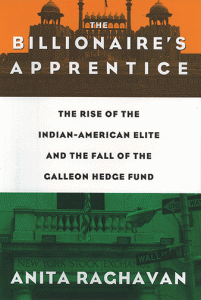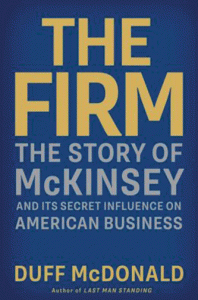Two books examine the financial legerdemain
that helped spark the Great Recession.
[column col=”1/4″]

THE BILLIONAIRE’S APPRENTICE:
The Rise of the Indian-American Elite
and the Fall of the Galleon Hedge Fund
By Anita Raghavan C’86
Business Plus, 2013, $29.

THE FIRM: The Story of McKinsey and Its Secret Influence on American Business
By Duff McDonald W’92
Simon & Schuster, 2013, $30.
[/column]
By Dennis Drabelle | The Billionaire’s Apprentice features more than its share of high-flying—and then free-falling—Penn grads, and who better to map their trajectories than a fellow alum? Most of the wrongdoers are also of Indian or Sri Lankan ancestry, and the author has that in common with them, too. Former Wall Street Journal reporter Anita Raghavan C’86 describes the book as the culmination of her long search for “an engaging way to write about the South Asian diaspora in the United States.” Engaging The Billionaire’s Apprentice certainly is. It’s also scathing, ending as it does with a slew of criminal convictions, but Raghavan never flinches in the telling.
Wisely, she starts by providing a cast of characters—useful for keeping track of the connections made and exploited in this complex saga of insider trading. At the center of the web is Raj Rajaratnam WG’83, capo of the Galleon Group, a hedge fund specializing in technology stocks. Raj, his brother Rengan, and several of their peers came to the States as products of elite South Asian prep schools modeled on Eton and its English brethren. As Raghavan points out, the immigrants benefited from a pair of 20th-century socio-political upheavals: Indian independence, which led to improvements in education that are helping the subcontinent “catch up with the rest of the world”; and the triumph of the American civil-rights movement, which opened up new opportunities to people of color.
Wall Street, however, was slow to accept the changes, and the limits imposed on ambitious young men like the Rajaratnams reinforced their tendency to bond with and do professional favors for each other. The elder brother, Raghavan notes, “understood how the system worked. If he couldn’t get into anyone else’s club, he’d build his own.”
Raj Rajaratnam was far from untalented. A skilled analyst of technology stocks, he exuded an air of confident rectitude that attracted investors. By 1997, he was a founder and the boss of Galleon; four years later, its assets put it among the world’s 10 biggest hedge funds. In 2008, he ranked as one of only six Asians on the Forbes list of the 400 Richest People in America.
What almost no one knew was that Rajaratnam’s dazzling performance rested in part on his ability to find and manipulate moles in other companies. Among the best of these was fellow South Asian Roomy Khan, who peddled her advance knowledge of earnings about to be reported by her employer, the semiconductor manufacturer Intel. The Intel hierarchy suspected it had a leaker in the house and went into sleuth mode. In one of the book’s most dramatic scenes, Khan is shown faxing documents to Rajaratnam, unaware that a “hidden camera that Intel had fixed above the fax machine captured her every movement.” Aided by a crony, Khan also fed Rajaratnam tips about Hilton Hotels, and one day in 2007 he made $4 million by purchasing stock in that company shortly before it was acquired by the Blackstone Group. This proved to be a blunder because it put the Securities and Exchange Commission on alert. For a technology fund to make such a big killing in an unrelated field was, in Raghavan’s words, to “raise red flags.” Khan soon “flipped,” helping federal prosecutors build a case against Rajaratnam.
Another mole, Rajaratnam’s classmate Anil Kumar WG’83, fell into the habit of doubly breaking faith: he fed Rajaratnam information that clients had entrusted to Kumar’s employer, the venerable management consulting firm McKinsey & Company. (In the interest of covering tracks, Kumar’s recompense went straight into the Swiss bank account of his housekeeper, whose net worth jumped by hundreds of thousands of dollars.)
Rajaratnam was also pals with McKinsey managing director Rajat Gupta, one of the diaspora’s most esteemed and plugged-in members (and, for the record, a graduate of Harvard Business School). As both a board member of Goldman Sachs and an investor in Galleon, Gupta tipped off Rajaratnam as to when it was propitious to buy Goldman Sachs shares. By now, federal prosecutors were wiretapping Rajaratnam’s telephone, and Gupta swam into their ken. In Raghavan’s view, Gupta is a tragic figure who negated the good will he had accumulated as a philanthropist and a mentor to other Indian Americans.
Rajaratnam and Kumar were arrested in 2009. The case against Gupta took longer to mature; he turned himself in to the FBI in 2011. Kumar flipped, too—one of Raghavan’s chapters is titled “Kumar Sings”—and pled guilty. The other two were convicted, and Rajaratnam’s jail sentence of 11 years was the longest ever meted out for insider trading. That some of the prosecutors were themselves of Indian origin adds poignancy to the story.
The Firm, a history of McKinsey by Fortune contributing editor Duff McDonald W’92, has hardly gotten underway when the fallout from the Galleon affair is assessed: “the … scandal has shaken the firm to its roots. Even though Anil Kumar sold client secrets and Rajat Gupta trashed the firm’s long-cherished value system in a public and mortifying way, neither event really affected the firm’s business. The damage to its self-image has been much more severe.”
McKinsey was founded in the 1920s (the exact date is lost in the murk of time) by James O. McKinsey, who had a knack for analyzing going concerns. Calling his service “management engineering,” he came to the aid of entrepreneurs who were good at creating and building a business, but not so hot at running it, especially when proliferating product lines called for decentralization. McKinsey took the next step of doing some managing himself, as head of the Marshall Field department stores, but that proved to be an aberration. After his death in 1937, his McKinsey successor, Marvin Bower, made sure that the firm stuck to its specialty: advising other companies on how to reorganize themselves and plan strategically. McKinsey operated with such diligence, polish, and probity as to be considered a kind of “secular priesthood.”
In the 1950s, President Eisenhower embraced McKinsey’s suggestion that the executive branch would function more smoothly with a chief of staff, as indeed it has ever since. From its bases in Chicago and New York, the firm expanded to booming postwar Europe. The Brits were impressed enough to use McKinsey as a verb, defined by the Sunday Times as “To shake up, reorganize, declare redundant …” Declare redundant, in turn, is a synonym for “lay off,” and McDonald points out that McKinsey’s recommendations have long favored management at the expense of workers.
The best indicator of growth may have been not the revenue stream, but rather McKinsey’s claim in 2003 to have “100 of the largest 150 companies on the planet as clients.” Not even McKinsey’s close ties with Enron—the infamous natural-gas-trading company that collapsed in a fiasco of over-expansion and fraud in 2001—posed much of a stumbling block.
Under Gupta’s leadership, McKinsey retired its noble rule of not accepting fees in the form of equity in the companies being counseled. (The idea had been that McKinsey should be giving disinterested advice, not positioning itself to benefit if the advice panned out.) According to McDonald, McKinsey abetted the catastrophic burst of the American real-estate bubble in the 2000s by going along with the seductive assumption that “the past was a reliable indication of the future.”
McDonald attributes McKinsey’s nine decades of success to its ability to recruit top-notch analysts and clients, and tell managers what they want to hear. His book is not only readable (no small achievement ), but also raises a tantalizing question: with our universities turning out swarms of bright MBAs these days, why can’t a company hire a few of them and be its own McKinsey?
Dennis Drabelle is a contributing editor of The Washington Post Book World.




